8 Channel Dual-Mode Compressor/Gate with iTS Hysteresis and Flexible Channel Linking
Product Features
-
High-performance frequency-selective compression and gating with comprehensive control options
-
Intelligent Threshold Shift (iTS) gate hysteresis to avoid re-triggering by low frequency signals
-
Flexible channel linking allows multiple combinations of side chain summing to preserve stereo images
-
Solo bus allows monitoring of the side chain control signals without affecting channel outputs
-
RMS and "Vintage" peak-sensing compressor modes
-
Soft or hard knee compressor response
-
Side chain band-pass filter allows frequency-selective compression or gating for creative and corrective control
-
External side chain input on balanced 1/4" TRS connector for each channel
-
Electronically balanced inputs and outputs on Neutrik* XLR connectors
-
Rugged 3U rackmount chassis for durability in portable applications
-
Auto-ranging universal switch-mode power supply
-
Designed and engineered in the U.K.
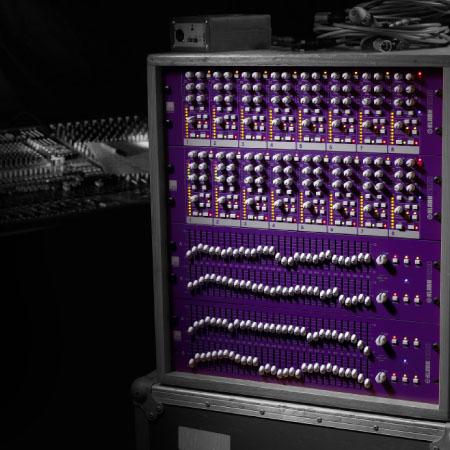
SQ1D
A veritable tool box of dynamics processing, SQ1D provides 8 channels of either compression or gating in a compact 3U high rack unit. This tightly integrated form factor allows the channels to be used together with ease, and includes highly flexible options for channel linking and side chain filtering and monitoring. SQ1D features multiple compression modes with combinations of RMS and Peak sensing and Hard and Soft Knee characteristics, ideal for both corrective and creative dynamics processing. In conjunction with the fully-featured noise gate and side chain options, one SQ1D can replace multiple other dynamics processors with considerable savings in space, weight and cost, with the confidence of knowing that whatever the application, SQ1D is more than capable of providing the required dynamic control of signal levels.
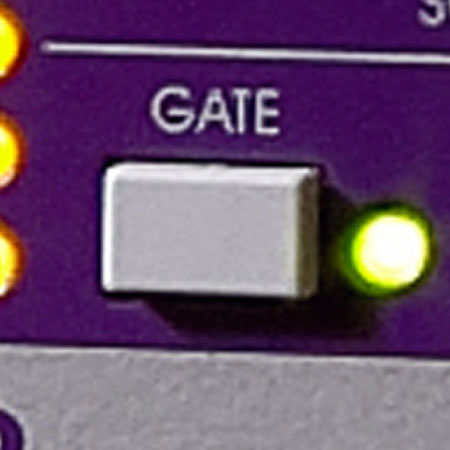
Intelligent Threshold Shift (iTS)
iTs operates in conjunction with the Gate Hold control to reduce false triggering of noise gates. When signals (especially low frequency ones) are very close to the gate threshold, a gate can repeatedly open and close on the programme material. iTS ensures that the gate remains open by automatically adjusting the gate threshold downwards the moment the signal goes over the threshold setting. When the signal eventually falls below the (new) temporarily adjusted threshold, the iTS function resets, ready for the next gate opening. This hysteresis action results in more decisive operation of the noise gates, and attack envelopes also start instantly and consistently, even on signals that are only slightly over threshold.
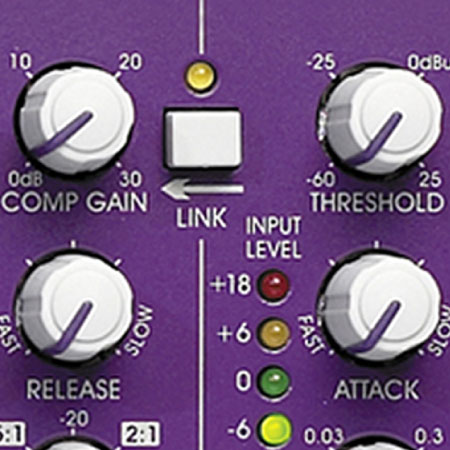
Flexible Channel Linking
Adjacent channels can be linked in any combination for stereo or multichannel operation. When any number of adjacent channels are linked, the linked channels all adopt the operating mode (compressor or noise gate) of the left-hand channel of the linked group. This channel’s settings now control all the members of that group, with only the make-up gain and Side chain filter frequency controls independent for optimising the action of the compressor or gate for each channel.

Independent Side Chain Monitoring
SQ1D overcomes a common issue with many outboard dynamics processors, where the side chain listen function is routed to the main output when engaged, which prevents mix engineers utilising this essential function during a live performance. SQ1D features an additive console-style Solo Bus which allows monitoring of the incoming signals at source and the fine-tuning of the side chain filters. Dedicated input and output XLR connectors allow this bus to be cascaded between multiple units and connected to a spare input channel or auxiliary return on the mixing console, for easy and convenient monitoring by the mix engineer. A Solo In Place button is included which will route the side chain signals directly to the audio outputs, a useful feature during the set-up for a show.
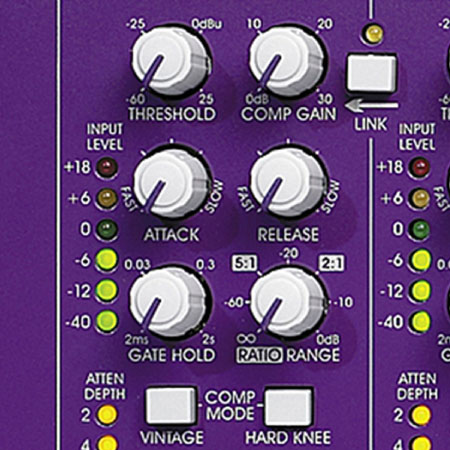
Multiple Compression Modes
SQ1D features a “Vintage” switch allowing the selection of the default RMS sensing compression mode, or when engaged, an emulation of many older compressor designs with exponential attack and release envelopes. When used in conjunction with the “Hard Knee” switch, SQ1D provides several different forms of compression to suit a wide range of programme material. By default, SQ1D offers a Soft Knee response, however when the “Hard Knee” switch is activated, a Hard Knee response is provided instead.
With both mode switches inactive the compressor behaves in the default RMS and Soft Knee modes. This gives the slowest (and most subtle) feel to the compressor envelopes. The soft knee curve combines with the adaptive RMS attack and release times to produce gentle envelope responses that are ideal for compressing sung vocals, but which can still be aggressive enough to limit transients when needed. The Soft Knee curve also reduces the adaptive nature of the RMS detection slightly, providing a little more manual control of the envelope timings than is the case below.
When the Hard Knee response is used with RMS mode, the compressor operates in a more clinical way with a more defined transition between under threshold and over threshold - this is better suited to limiting style compression. A small amount of the soft knee curve is still retained keeping the sound reasonably natural but with no modification of the compressor envelope. This means that attacks are more aggressive, but it also allows the adaptive nature of the RMS detection to operate to its fullest extent. This mode is good for natural sounding limiting of speech.
With the “Vintage” switch active and the default Soft Knee response selected, the compressor employs a dual time constant, linear attack profile. This produces extremely subtle attack and release curves during the onset of compression that are largely independent of the envelope control settings. As the compressor is driven harder (i.e. signals further over threshold) the soft knee effect reduces, gradually returning manual control of the attack and release times to optimise capture of larger transients. Like the RMS modes, this compressor mode is very adaptive making set up of the envelope controls relatively easy. The peak sensing, however, increases harmonic overtones, which add a “Vintage” brightness and sparkle to the programme, producing extremely transparent and lively sounding compression of acoustic instruments.
When both the “Vintage” and “Hard Knee” switches are selected, the compressor operates with more precise envelope control and a defined transition between under- and over-threshold. This produces aggressive compression that gives fast control of extremely dynamic material. It can also be used to add colour to low frequency signals making it ideal for controlling instruments such as bass guitar. With the highest ratio setting, this mode allows the compressor to effectively be used as a limiter.
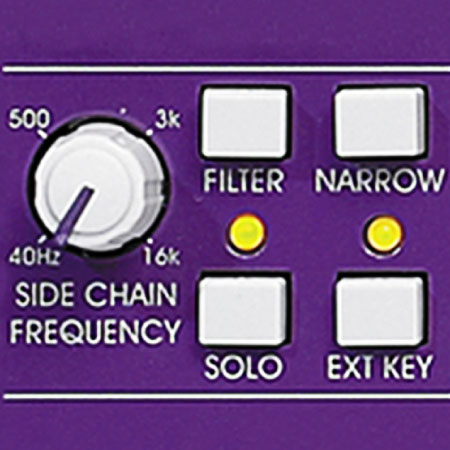
Frequency-Selective Compression and Gating
Each channel side chain is equipped with a selectable bandpass filter with wide and narrow responses. This powerful feature greatly extends the capabilities of the multiple compression and gating modes. Frequency-selective compression is a very effective and creative alternative to equalisation, with the wide bandpass filter response being ideal to enhance the essential character of an instrument, allowing it to stand out in a mix without the use of harsh- or unnatural-sounding boosted EQ responses. The SQ1D can also be used as a frequency-selective De-esser by selecting the narrow bandpass filter response to reduce sibilance or other undesirable artefacts from vocals, or to remove specific resonances from instruments or programme material. When the SQ1D is operating as a noise gate, the side chain filter can be used to select the key frequency component in programme material that can be used to trigger the operation of the gate, especially useful with drums kits and percussion instruments.
The flexibility of the side chains is enhanced by the inclusion of a dedicated side chain input for each channel on a balanced ¼ " TRS connector.
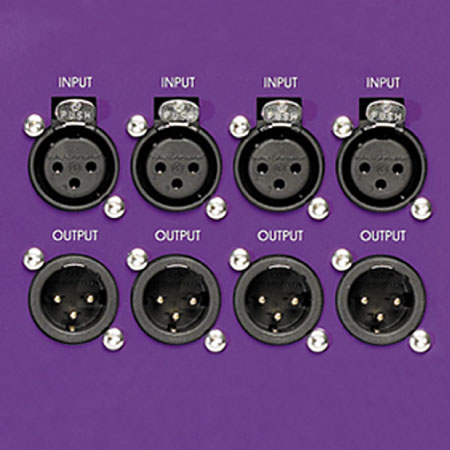
Built for the Road
Featuring a rugged steel 3U rackmount enclosure, the SQ1D is designed for the rigours of live concert touring. Premium Neutrik XLR connectors are used to ensure reliable audio connections, night after night.
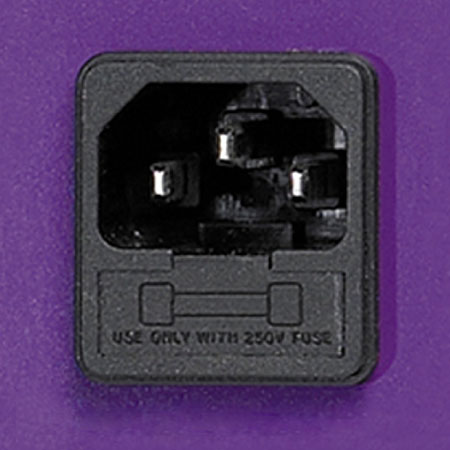
Auto-Ranging Universal Switch-Mode Power Supply
SQ1D features a universal power supply, which is auto-voltage sensing for use on a worldwide basis.
SQ1D
8 Channel Dual-Mode Compressor/Gate with iTS Hysteresis and Flexible Channel Linking
Product Features
-
High-performance frequency-selective compression and gating with comprehensive control options
-
Intelligent Threshold Shift (iTS) gate hysteresis to avoid re-triggering by low frequency signals
-
Flexible channel linking allows multiple combinations of side chain summing to preserve stereo images
-
Solo bus allows monitoring of the side chain control signals without affecting channel outputs
-
RMS and "Vintage" peak-sensing compressor modes
-
Soft or hard knee compressor response
-
Side chain band-pass filter allows frequency-selective compression or gating for creative and corrective control
-
External side chain input on balanced 1/4" TRS connector for each channel
-
Electronically balanced inputs and outputs on Neutrik* XLR connectors
-
Rugged 3U rackmount chassis for durability in portable applications
-
Auto-ranging universal switch-mode power supply
-
Designed and engineered in the U.K.

SQ1D
A veritable tool box of dynamics processing, SQ1D provides 8 channels of either compression or gating in a compact 3U high rack unit. This tightly integrated form factor allows the channels to be used together with ease, and includes highly flexible options for channel linking and side chain filtering and monitoring. SQ1D features multiple compression modes with combinations of RMS and Peak sensing and Hard and Soft Knee characteristics, ideal for both corrective and creative dynamics processing. In conjunction with the fully-featured noise gate and side chain options, one SQ1D can replace multiple other dynamics processors with considerable savings in space, weight and cost, with the confidence of knowing that whatever the application, SQ1D is more than capable of providing the required dynamic control of signal levels.

Intelligent Threshold Shift (iTS)
iTs operates in conjunction with the Gate Hold control to reduce false triggering of noise gates. When signals (especially low frequency ones) are very close to the gate threshold, a gate can repeatedly open and close on the programme material. iTS ensures that the gate remains open by automatically adjusting the gate threshold downwards the moment the signal goes over the threshold setting. When the signal eventually falls below the (new) temporarily adjusted threshold, the iTS function resets, ready for the next gate opening. This hysteresis action results in more decisive operation of the noise gates, and attack envelopes also start instantly and consistently, even on signals that are only slightly over threshold.

Flexible Channel Linking
Adjacent channels can be linked in any combination for stereo or multichannel operation. When any number of adjacent channels are linked, the linked channels all adopt the operating mode (compressor or noise gate) of the left-hand channel of the linked group. This channel’s settings now control all the members of that group, with only the make-up gain and Side chain filter frequency controls independent for optimising the action of the compressor or gate for each channel.

Independent Side Chain Monitoring
SQ1D overcomes a common issue with many outboard dynamics processors, where the side chain listen function is routed to the main output when engaged, which prevents mix engineers utilising this essential function during a live performance. SQ1D features an additive console-style Solo Bus which allows monitoring of the incoming signals at source and the fine-tuning of the side chain filters. Dedicated input and output XLR connectors allow this bus to be cascaded between multiple units and connected to a spare input channel or auxiliary return on the mixing console, for easy and convenient monitoring by the mix engineer. A Solo In Place button is included which will route the side chain signals directly to the audio outputs, a useful feature during the set-up for a show.

Multiple Compression Modes
SQ1D features a “Vintage” switch allowing the selection of the default RMS sensing compression mode, or when engaged, an emulation of many older compressor designs with exponential attack and release envelopes. When used in conjunction with the “Hard Knee” switch, SQ1D provides several different forms of compression to suit a wide range of programme material. By default, SQ1D offers a Soft Knee response, however when the “Hard Knee” switch is activated, a Hard Knee response is provided instead.
With both mode switches inactive the compressor behaves in the default RMS and Soft Knee modes. This gives the slowest (and most subtle) feel to the compressor envelopes. The soft knee curve combines with the adaptive RMS attack and release times to produce gentle envelope responses that are ideal for compressing sung vocals, but which can still be aggressive enough to limit transients when needed. The Soft Knee curve also reduces the adaptive nature of the RMS detection slightly, providing a little more manual control of the envelope timings than is the case below.
When the Hard Knee response is used with RMS mode, the compressor operates in a more clinical way with a more defined transition between under threshold and over threshold - this is better suited to limiting style compression. A small amount of the soft knee curve is still retained keeping the sound reasonably natural but with no modification of the compressor envelope. This means that attacks are more aggressive, but it also allows the adaptive nature of the RMS detection to operate to its fullest extent. This mode is good for natural sounding limiting of speech.
With the “Vintage” switch active and the default Soft Knee response selected, the compressor employs a dual time constant, linear attack profile. This produces extremely subtle attack and release curves during the onset of compression that are largely independent of the envelope control settings. As the compressor is driven harder (i.e. signals further over threshold) the soft knee effect reduces, gradually returning manual control of the attack and release times to optimise capture of larger transients. Like the RMS modes, this compressor mode is very adaptive making set up of the envelope controls relatively easy. The peak sensing, however, increases harmonic overtones, which add a “Vintage” brightness and sparkle to the programme, producing extremely transparent and lively sounding compression of acoustic instruments.
When both the “Vintage” and “Hard Knee” switches are selected, the compressor operates with more precise envelope control and a defined transition between under- and over-threshold. This produces aggressive compression that gives fast control of extremely dynamic material. It can also be used to add colour to low frequency signals making it ideal for controlling instruments such as bass guitar. With the highest ratio setting, this mode allows the compressor to effectively be used as a limiter.

Frequency-Selective Compression and Gating
Each channel side chain is equipped with a selectable bandpass filter with wide and narrow responses. This powerful feature greatly extends the capabilities of the multiple compression and gating modes. Frequency-selective compression is a very effective and creative alternative to equalisation, with the wide bandpass filter response being ideal to enhance the essential character of an instrument, allowing it to stand out in a mix without the use of harsh- or unnatural-sounding boosted EQ responses. The SQ1D can also be used as a frequency-selective De-esser by selecting the narrow bandpass filter response to reduce sibilance or other undesirable artefacts from vocals, or to remove specific resonances from instruments or programme material. When the SQ1D is operating as a noise gate, the side chain filter can be used to select the key frequency component in programme material that can be used to trigger the operation of the gate, especially useful with drums kits and percussion instruments.
The flexibility of the side chains is enhanced by the inclusion of a dedicated side chain input for each channel on a balanced ¼ " TRS connector.

Built for the Road
Featuring a rugged steel 3U rackmount enclosure, the SQ1D is designed for the rigours of live concert touring. Premium Neutrik XLR connectors are used to ensure reliable audio connections, night after night.

Auto-Ranging Universal Switch-Mode Power Supply
SQ1D features a universal power supply, which is auto-voltage sensing for use on a worldwide basis.
8 Channel Dual-Mode Compressor/Gate with iTS Hysteresis and Flexible Channel Linking
Product Features
-
High-performance frequency-selective compression and gating with comprehensive control options
-
Intelligent Threshold Shift (iTS) gate hysteresis to avoid re-triggering by low frequency signals
-
Flexible channel linking allows multiple combinations of side chain summing to preserve stereo images
-
Solo bus allows monitoring of the side chain control signals without affecting channel outputs
-
RMS and "Vintage" peak-sensing compressor modes
-
Soft or hard knee compressor response
-
Side chain band-pass filter allows frequency-selective compression or gating for creative and corrective control
-
External side chain input on balanced 1/4" TRS connector for each channel
-
Electronically balanced inputs and outputs on Neutrik* XLR connectors
-
Rugged 3U rackmount chassis for durability in portable applications
-
Auto-ranging universal switch-mode power supply
-
Designed and engineered in the U.K.

SQ1D
A veritable tool box of dynamics processing, SQ1D provides 8 channels of either compression or gating in a compact 3U high rack unit. This tightly integrated form factor allows the channels to be used together with ease, and includes highly flexible options for channel linking and side chain filtering and monitoring. SQ1D features multiple compression modes with combinations of RMS and Peak sensing and Hard and Soft Knee characteristics, ideal for both corrective and creative dynamics processing. In conjunction with the fully-featured noise gate and side chain options, one SQ1D can replace multiple other dynamics processors with considerable savings in space, weight and cost, with the confidence of knowing that whatever the application, SQ1D is more than capable of providing the required dynamic control of signal levels.

Intelligent Threshold Shift (iTS)
iTs operates in conjunction with the Gate Hold control to reduce false triggering of noise gates. When signals (especially low frequency ones) are very close to the gate threshold, a gate can repeatedly open and close on the programme material. iTS ensures that the gate remains open by automatically adjusting the gate threshold downwards the moment the signal goes over the threshold setting. When the signal eventually falls below the (new) temporarily adjusted threshold, the iTS function resets, ready for the next gate opening. This hysteresis action results in more decisive operation of the noise gates, and attack envelopes also start instantly and consistently, even on signals that are only slightly over threshold.

Flexible Channel Linking
Adjacent channels can be linked in any combination for stereo or multichannel operation. When any number of adjacent channels are linked, the linked channels all adopt the operating mode (compressor or noise gate) of the left-hand channel of the linked group. This channel’s settings now control all the members of that group, with only the make-up gain and Side chain filter frequency controls independent for optimising the action of the compressor or gate for each channel.

Independent Side Chain Monitoring
SQ1D overcomes a common issue with many outboard dynamics processors, where the side chain listen function is routed to the main output when engaged, which prevents mix engineers utilising this essential function during a live performance. SQ1D features an additive console-style Solo Bus which allows monitoring of the incoming signals at source and the fine-tuning of the side chain filters. Dedicated input and output XLR connectors allow this bus to be cascaded between multiple units and connected to a spare input channel or auxiliary return on the mixing console, for easy and convenient monitoring by the mix engineer. A Solo In Place button is included which will route the side chain signals directly to the audio outputs, a useful feature during the set-up for a show.

Multiple Compression Modes
SQ1D features a “Vintage” switch allowing the selection of the default RMS sensing compression mode, or when engaged, an emulation of many older compressor designs with exponential attack and release envelopes. When used in conjunction with the “Hard Knee” switch, SQ1D provides several different forms of compression to suit a wide range of programme material. By default, SQ1D offers a Soft Knee response, however when the “Hard Knee” switch is activated, a Hard Knee response is provided instead.
With both mode switches inactive the compressor behaves in the default RMS and Soft Knee modes. This gives the slowest (and most subtle) feel to the compressor envelopes. The soft knee curve combines with the adaptive RMS attack and release times to produce gentle envelope responses that are ideal for compressing sung vocals, but which can still be aggressive enough to limit transients when needed. The Soft Knee curve also reduces the adaptive nature of the RMS detection slightly, providing a little more manual control of the envelope timings than is the case below.
When the Hard Knee response is used with RMS mode, the compressor operates in a more clinical way with a more defined transition between under threshold and over threshold - this is better suited to limiting style compression. A small amount of the soft knee curve is still retained keeping the sound reasonably natural but with no modification of the compressor envelope. This means that attacks are more aggressive, but it also allows the adaptive nature of the RMS detection to operate to its fullest extent. This mode is good for natural sounding limiting of speech.
With the “Vintage” switch active and the default Soft Knee response selected, the compressor employs a dual time constant, linear attack profile. This produces extremely subtle attack and release curves during the onset of compression that are largely independent of the envelope control settings. As the compressor is driven harder (i.e. signals further over threshold) the soft knee effect reduces, gradually returning manual control of the attack and release times to optimise capture of larger transients. Like the RMS modes, this compressor mode is very adaptive making set up of the envelope controls relatively easy. The peak sensing, however, increases harmonic overtones, which add a “Vintage” brightness and sparkle to the programme, producing extremely transparent and lively sounding compression of acoustic instruments.
When both the “Vintage” and “Hard Knee” switches are selected, the compressor operates with more precise envelope control and a defined transition between under- and over-threshold. This produces aggressive compression that gives fast control of extremely dynamic material. It can also be used to add colour to low frequency signals making it ideal for controlling instruments such as bass guitar. With the highest ratio setting, this mode allows the compressor to effectively be used as a limiter.

Frequency-Selective Compression and Gating
Each channel side chain is equipped with a selectable bandpass filter with wide and narrow responses. This powerful feature greatly extends the capabilities of the multiple compression and gating modes. Frequency-selective compression is a very effective and creative alternative to equalisation, with the wide bandpass filter response being ideal to enhance the essential character of an instrument, allowing it to stand out in a mix without the use of harsh- or unnatural-sounding boosted EQ responses. The SQ1D can also be used as a frequency-selective De-esser by selecting the narrow bandpass filter response to reduce sibilance or other undesirable artefacts from vocals, or to remove specific resonances from instruments or programme material. When the SQ1D is operating as a noise gate, the side chain filter can be used to select the key frequency component in programme material that can be used to trigger the operation of the gate, especially useful with drums kits and percussion instruments.
The flexibility of the side chains is enhanced by the inclusion of a dedicated side chain input for each channel on a balanced ¼ " TRS connector.

Built for the Road
Featuring a rugged steel 3U rackmount enclosure, the SQ1D is designed for the rigours of live concert touring. Premium Neutrik XLR connectors are used to ensure reliable audio connections, night after night.

Auto-Ranging Universal Switch-Mode Power Supply
SQ1D features a universal power supply, which is auto-voltage sensing for use on a worldwide basis.
other products
SHIPPING
Domestic delivery only
PRODUCT WARRANTY
For electric and electronic product only.
MAINTENANCE
Only products purchased from importers and dealer that has a warranty on the product.









